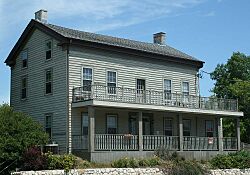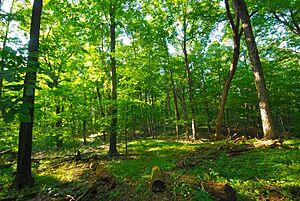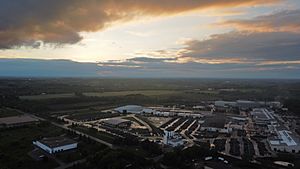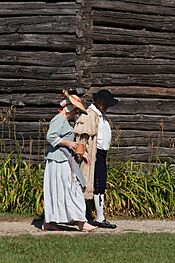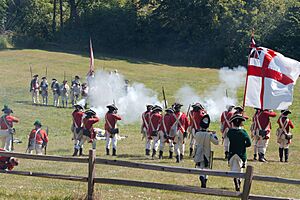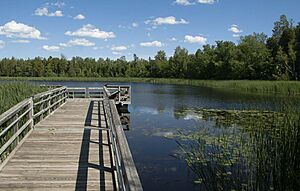Saukville, Wisconsin facts for kids
Quick facts for kids
Saukville, Wisconsin
|
|
|---|---|
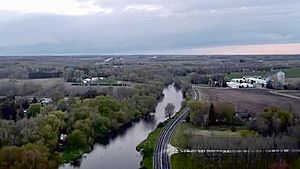
The Milwaukee River in Saukville, Wisconsin
|
|
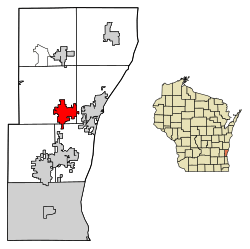
Location of Saukville in Ozaukee County, Wisconsin.
|
|
| Country | |
| State | |
| County | Ozaukee |
| Settled | c. 1845 |
| Incorporated | 1915 |
| Area | |
| • Total | 3.57 sq mi (9.25 km2) |
| • Land | 3.52 sq mi (9.12 km2) |
| • Water | 0.05 sq mi (0.13 km2) |
| Elevation | 889 ft (271 m) |
| Population
(2020)
|
|
| • Total | 4,258 |
| • Density | 1,259.02/sq mi (486.15/km2) |
| Time zone | UTC-6 (Central (CST)) |
| • Summer (DST) | UTC-5 (CDT) |
| Area code(s) | 262 |
| FIPS code | 55-71725 |
| GNIS feature ID | 1573739 |
Saukville is a village in Ozaukee County, Wisconsin, United States. It's located on the Milwaukee River and has a part along Interstate 43. This community is a suburb in the Milwaukee metropolitan area. In 2020, about 4,258 people lived here.
The center of Saukville was once a Native American village. It was at a spot where two important trails crossed. White settlers arrived in the mid-1840s. In its early days, Saukville was a stop for stagecoaches traveling from Milwaukee to Green Bay. It also grew as a place for mills and a market for local dairy farmers. The village officially became a village in 1915. Later in the 20th century, it became a suburban area with many factories. In 2019, over 40% of jobs in the village were in manufacturing. The biggest employers included a steel mill and several places that make metal products.
The village and the nearby Town of Saukville have many different kinds of bogs and coniferous swamps. The largest is the 2,200-acre Cedarburg Bog State Natural Area. These bogs are home to rare animals and plants, many types of birds, and even carnivorous plants. The Cedarburg Bog has a special feature called a string bog. This is a type of bog that is rarely found as far south as Wisconsin. It has many plants usually seen only in remote parts of Canada.
Contents
- Exploring Saukville's Past: A Look at Its History
- Understanding Saukville's Location and Natural Features
- Saukville's Population and People
- Saukville's Economy: How People Make a Living
- Culture and Fun in Saukville
- Learning in Saukville: Schools and Education
- Getting Around Saukville: Transportation
- Parks and Outdoor Fun in Saukville
- Famous People from Saukville
- See also
Exploring Saukville's Past: A Look at Its History
Saukville was once a Native American village. It was located where the Milwaukee River met two important trails. One trail became Green Bay Road, going north and south. The other became Dekora Road, going east and west. People lived in this area for many centuries before European settlers arrived. In the mid-1800s, a researcher named Increase A. Lapham found circular mounds and a stone ax near Saukville.
An interesting old artifact found here is the Ozaukee County Birdstone. A six-year-old farm boy discovered it in 1891. Many birdstones are very old, dating back to 3000 BCE to 500 BCE.
By the early 1800s, the Native Americans in the Saukville area were likely Menominee and Sauk people. They were forced to leave Wisconsin in the 1830s. White settlers started to arrive around 1845 and built homes along Green Bay Road.
Saukville was part of the town of Port Washington until 1848. That year, the Town of Saukville was created. In 1848, William Payne opened a stagecoach inn for travelers. This inn, called the Payne Hotel, is still standing today. It is listed on the National Register of Historic Places. Also in 1848, some residents built a dam on the Milwaukee River. Later, they built a saw mill and a grist mill. For many years, Saukville was a farming community with many dairy farmers.
In 1871, a train line was built in the community. This line later became part of the Chicago, Milwaukee & St. Paul Railway.
In 1915, the village of Saukville officially became a village. The vote was 66 in favor and 40 against. At that time, 376 people lived in the village.
After World War II, Saukville grew a lot. Between 1950 and 1980, the village's population grew five times. It went from 699 people to 3,494. The building of Interstate 43 in the mid-1960s connected Saukville to bigger cities like Milwaukee.
Understanding Saukville's Location and Natural Features
Saukville is located at 43°22′52″N 87°56′40″W / 43.38111°N 87.94444°W. The village covers about 3.85 square miles (9.97 square kilometers). Most of this area is land, with a small amount of water. The Town of Saukville borders the village to the north and west. Other towns like Port Washington and Grafton are to the east, south, and southwest.
The village is in an area shaped by glaciers from the last ice age. This area is called the Southeastern Wisconsin glacial till plains. Much of Saukville is on a rock formation called the Saukville Reef. This reef is part of the Racine Dolomite rock layer. It stretches across eastern Wisconsin and Illinois. This rock contains old Silurian sea fossils. While most of it is deep underground, you can see it at some old quarries in the northern part of the village.
Before settlers arrived, Saukville was covered by forests. These forests had many American beech and sugar maple trees. There were also white cedars along the Milwaukee River, which flows through Saukville. Much of this forest was cut down for farming. The Kurtz Woods State Natural Area in the village still has old trees. It shows what the original forests were like.
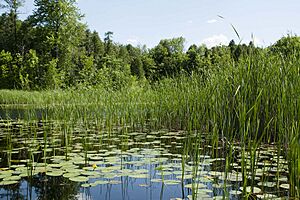
East of the village is the Cedarburg Bog. This is a 2,200-acre natural area. It is home to many rare plants and animals. The bog has two lakes and large swamps with white cedar and tamarack trees. It also has the southernmost string bog on Earth. A string bog is a special type of wetland with ridges and hollows. The bog is home to several carnivorous plants. These include bladderworts, pitcher plants, and sundews.
As more land is developed, wild animals sometimes come closer to human areas. You might see large animals like white-tailed deer, coyotes, North American river otters, and red foxes in the village. Many birds, such as great blue herons and wild turkeys, also live here.
The area also faces challenges from invasive species. These are plants and animals that are not native and can harm the local ecosystem. Examples include the emerald ash borer (an insect that harms ash trees) and plants like reed canary grass and purple loosestrife.
Saukville's Population and People
| Historical population | |||
|---|---|---|---|
| Census | Pop. | %± | |
| 1920 | 330 | — | |
| 1930 | 399 | 20.9% | |
| 1940 | 431 | 8.0% | |
| 1950 | 699 | 62.2% | |
| 1960 | 1,038 | 48.5% | |
| 1970 | 1,389 | 33.8% | |
| 1980 | 3,494 | 151.5% | |
| 1990 | 3,695 | 5.8% | |
| 2000 | 4,068 | 10.1% | |
| 2010 | 4,451 | 9.4% | |
| 2020 | 4,258 | −4.3% | |
| U.S. Decennial Census | |||
In 2010, there were 4,451 people living in Saukville. There were 1,766 households and 1,208 families. The village had about 1,171 people per square mile (452 per square kilometer).
Most of the people in the village were White (96.0%). Other groups included African American, Native American, and Asian residents. About 2.9% of the population was Hispanic or Latino.
About 36.2% of households had children under 18. Most households (53.6%) were married couples living together. The average age in the village was 36.7 years. About 26.2% of residents were under 18 years old.
Saukville's Economy: How People Make a Living
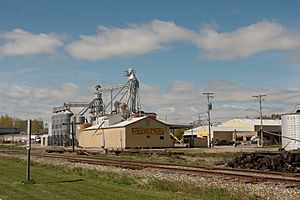
Saukville's economy first relied on farming. The first big businesses were mills on the Milwaukee River that used water power. These businesses served local farmers. In the late 1800s and early 1900s, dairy farming was a major industry. As the village grew, its economy became more diverse.
In 2019, manufacturing provided over 40% of local jobs. Three of the village's largest employers were metal manufacturers. Many of these factories are in the Dekora Woods Business and Industrial Park. This park is in north-central Saukville, west of Interstate 43.
| Largest Employers in Saukville, 2019 | |||
|---|---|---|---|
| Rank | Employer | Industry | Employees |
| 1 | Charter Steel | Iron, steel, and ferroalloy mill | 500-999 |
| 2 | Johnson Brass & Machine Foundry Inc. | Non-ferrous metal foundry | 100-249 |
| 3 | Sauk Technologies | Fabricated metal manufacturing | 100-249 |
| 4 | Walmart | Retail | 100-249 |
| 5 | YMCA | Civic and social organization | 100-249 |
| 6 | Jeneil Biotech Inc. | Spice and extract manufacturing | 50-99 |
| 7 | Oldenburg Metal Tech | Tool, die, and machining manufacturing | 50-99 |
| 8 | Pope Scientific | Industrial machine manufacturing | 50-99 |
| 9 | Piggly Wiggly | Retail (Grocery) | 50-99 |
| 10 | Eric von Schledorn Chevrolet Buick | Retail (car dealership) | 50-99 |
Culture and Fun in Saukville
Movies and Entertainment
The Marcus Corporation runs a large movie theater in Saukville. It has twelve screens for watching movies.
Local Events and Gatherings
The Saukville Area Historical Society holds the Crossroads Rendezvous. This event happens in Peninsula Park on the third weekend in May. It's a fun way to learn about the annual rendezvous gatherings. These gatherings were part of Wisconsin's fur trade in the 1700s and early 1800s. The event started in 1991 and ran until 2006. After a break, it began again in 2017.
The village also has a farmers market. It's held in Veterans Park every Sunday from June to October, from 9 a.m. to 1 p.m.
Museums to Explore
- Crossroads Museum: The Saukville Area Historical Society runs this museum. It's all about Saukville's local history. The museum is in a restored firehouse built in 1912. It's also the historical society's main office.
- Ozaukee County Pioneer Village: This outdoor museum is north of the village. It has twenty-four old buildings from the 1840s to the early 1900s. It shows what village life was like in early Ozaukee County.
Oscar Grady Public Library
The Oscar Grady Public Library has many books, digital resources, and old photos of the community. It offers reading programs for children. It is part of the Monarch Library System, which includes thirty-one libraries in nearby counties.
Places of Worship
Saukville has several churches. These include Living Hope Lutheran Church, Parkside Community United Church of Christ, and River of Life Lutheran Church. There is also St. John XXIII Catholic Church. This Catholic church was formed in 2016 by combining three churches. The parish also has a school in Port Washington for students up to eighth grade.
Learning in Saukville: Schools and Education
Saukville is part of the Port Washington-Saukville School District. Young students attend Saukville Elementary School for kindergarten through fourth grade. Then, they go to Thomas Jefferson Middle School for fifth through eighth grades. For high school, students attend Port Washington High School for ninth through twelfth grades.
A nine-member elected school board manages the district. They meet on Mondays at 6 p.m. in Port Washington. The district also has a full-time superintendent, Michael R. Weber.
The University of Wisconsin–Milwaukee Field Station is a 320-acre nature preserve. It's next to the Cedarburg Bog State Natural Area, west of the village. The field station is used by university students and teachers. They do research on biology and ecology there. It is not open to the public.
Getting Around Saukville: Transportation
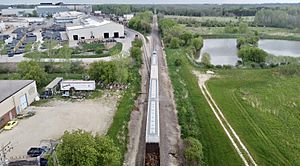
Interstate 43 runs through eastern Saukville. You can get on or off at Exit 96. The meeting point of Interstate 43 and Wisconsin Highway 57 is at the village's northeast edge.
Saukville has some public transportation. Ozaukee County and the Milwaukee County Transit System run the Route 143 commuter bus. This bus, called the "Ozaukee County Express," goes to Milwaukee using Interstate 43. The bus stops in the Saukville Walmart parking lot. This stop is the end of the bus route to the north. The bus runs Monday through Friday during busy travel times.
Ozaukee County Transit Services also offers a Shared Ride Taxi. This is a public taxi service for places not directly on the interstate. The taxis run seven days a week. They can connect you to other transit services in Washington County and Milwaukee County.
One freight train line goes through the village. South of Saukville, the line is run by the Wisconsin Central Ltd. railroad. This is part of the Canadian National Railway. North of Saukville, the Wisconsin and Southern Railroad operates the line. Saukville does not currently have a passenger train station.
Parks and Outdoor Fun in Saukville
The Village of Saukville has eight town parks. These parks have fields for baseball, softball, football, and soccer. They also have courts for basketball, tennis, and volleyball. You can find playgrounds and picnic areas. Some parks offer access to the Milwaukee River for fishing and canoeing. The village also organizes youth baseball and softball leagues.
The nearby Town of Saukville has five Ozaukee County Parks along the Milwaukee River. These parks cover over 200 acres. They include the H. H. Peters Youth Camp and the Ozaukee County Pioneer Village. Pioneer Village is an open-air museum with twenty-four historic buildings.
The town is also home to four Wisconsin State Natural Areas. One of these is the 2,200-acre Cedarburg Bog. This bog is a National Natural Landmark. It is the largest and best-preserved bog in eastern Wisconsin. It has hiking trails and boardwalks. There are more than a dozen bogs in the Saukville area. These bogs have many different kinds of plants and animals that are rare in other parts of Wisconsin.
The Riveredge Nature Center is a private, nonprofit center. Its 61-acre property has unique landforms created by glaciers and diverse wildlife. The center offers educational programs all year. The Blue Heron Wildlife Sanctuary is another private, nonprofit nature center. It has 92 acres of land north of the village. The sanctuary has hiking trails and facilities for helping injured wildlife.
The Saukville area also has several golf courses. Ozaukee County has the public 18-hole Hawthorne Hills Golf Course. The Bog is a private, 18-hole golf course designed by Arnold Palmer. It is located east of the Cedarburg Bog.
Famous People from Saukville
- Robert Brooks, a Wisconsin State Representative and businessman
- Tom Uttech, an artist
See also
 In Spanish: Saukville (Wisconsin) para niños
In Spanish: Saukville (Wisconsin) para niños


